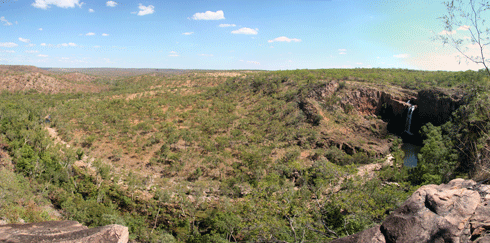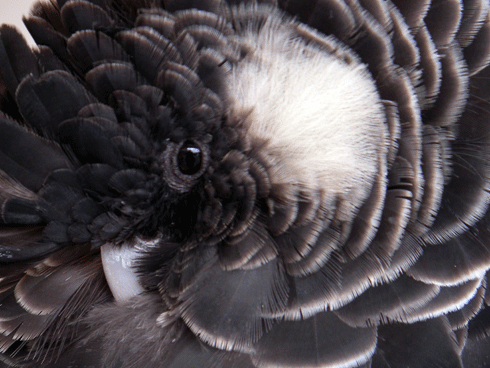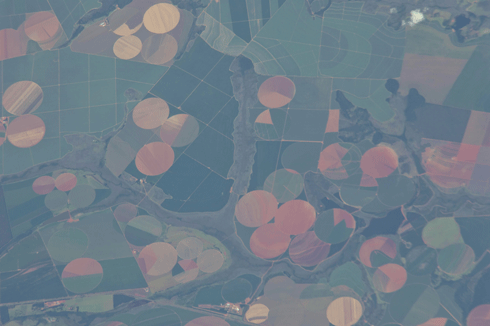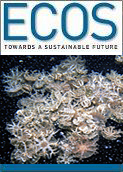
|
Published: 24 September 2012
Climate change and conservation: no going back now
In the face of the rapidly emerging, large-scale impacts of climate change, a recently released CSIRO report highlights the need for Australia to rethink its approach to biodiversity conservation and the national reserve system.
When A.G. Tansley – a famous ecologist of the early twentieth century – was asked what he meant by nature conservation, he defined it as maintaining the world in the state he knew as a child.
In the Anthropocene, as human effects on Earth’s ecosystems intensify, returning ecosystems to idealised pre-disturbance states is no longer a viable goal for nature conservation. The cumulative impacts of landscape modification, land-use intensification, landscape fragmentation, and now climate change – among other human activities – have reached a point where the old conservation paradigms need to be rethought.
Dr Michael Dunlop of CSIRO’s Ecosystem Sciences is lead author of a recently released report on climate change, biodiversity conservation and Australia’s national reserve system.
The report is based on an assessment of the sensitivity of Australian biodiversity to climate change. Background research included analyses of potential impacts of climate change and adaptation options in four ‘priority biomes’ (regional-scale ecosystems with broadly similar climates) across Australia:
-
northern savanna grasslands (Queensland, Northern Territory, Western Australia)
-
south-east Australian sclerophyll forests (New South Wales, Victoria, Australian Capital Territory, Tasmania, Queensland, South Australia)
-
hummock grasslands of Central Australia, spinifex grasslands, and acacia and eucalypt woodlands with spinifex understory (Western Australia, South Australia, Northern Territory, western Queensland and New South Wales)
-
temperate lowland grassy ecosystems (eastern Australia).
According to the report, the magnitude, pace and diverse nature of climate change impacts on biodiversity mean we may need to move away from the ‘ecosystem stocks’ approach of managing static assemblages of species. Rather than trying to preserve current biodiversity states, we should instead consider a range of biodiversity values. These values include those associated with what the report terms ‘dynamic biodiversity’.
‘A lot of biodiversity strategies are focused on species rather than other aspects of biodiversity that are valued by society,' says Dr Dunlop. 'Different aspects of biodiversity – for example, the health of ecosystems [or] the extent of area dominated by natural processes – are not necessarily reflected equally in our current legislation and strategy.
‘We [the report’s authors] feel that under climate change, there may be some need to look again at that balance.’
Martin Taylor, conservation scientist with WWF-Australia, agrees that climate change will throw up significant challenges to traditional conservation strategies.
‘If we’re going to see landscape-scale shifts in species – in other words, if we’re going to see species that don’t normally live in a particular protected area suddenly turning up – what do you do?,’ asks Dr Taylor.
‘The old view, I guess, was to say “Well, no, that’s an alien species and we don’t want it here.” But now, of course, we have to think again perhaps and say, “Well, this is going to be the kind of species turnover that we have to live with,” and stop trying to put your finger on the dyke and stop these kinds of changes.’
Current biodiversity management strategies largely assume low levels of species loss, relatively high levels of knowledge about threats and the state of biodiversity, and relatively static environments. In contrast, climate change will bring high levels of change in biodiversity, and increasing uncertainty about the state of species, ecosystems and landscapes.
‘The static nature of current conservation objectives are not geared up for this level of change,’ says Dr Dunlop. ‘We need strategies that are “robust to uncertainty”.’
Among these strategies is ‘stepwise management’. In contrast to intensive management to maintain ecosystem types, stepwise management involves stepping-stone strategies that allow for changes in direction as new information becomes available.
Another approach is to adopt strategies effective under a wide range of future magnitudes and types of change, for a wide range of species. According to Dr Dunlop, Australia’s national reserve system (NRS) is a good example of a climate-resilient approach.
‘The planning framework for the NRS is to capture as much variation in habitat type as possible,' he explains.
'What that means is that even if the climate changes, the environment changes and the species in any one reserve change, [then] across the whole set of reserves we’re still going to have a wide variety of habitat set aside for native biodiversity to live in. So that increases the chance that species will be able to find somewhere to survive.’
With public consciousness of biodiversity being species-focused, communicating the kind of dynamic biodiversity values discussed in the report – such as ecosystem health, and the balance of natural and human activities – is a challenge. Dr Dunlop believes one way to communicate alternative biodiversity values is by focusing on the actual human experience of the natural world.
‘If you approach it from the angle of how people experience biodiversity – what do they do in order to seek it out, what do they value, what are they likely to be upset about if it's threatened – then I think it becomes easier to explore with people these other aspects of biodiversity.
‘So if someone is going to go for a bushwalk or a picnic, or they’re enjoying the elements of native biodiversity in a landscape as they drive through it, they’re all things that feed the soul and make you want to conserve biodiversity. They might not have anything to do with threatened species.’
Translating dynamic biodiversity values such as ‘ecosystem health’ into robust, measurable and reportable scientific concepts is, as Dr Dunlop points out, possibly an even harder challenge.
'There is something intuitive about ecosystem health, but putting your finger on it scientifically is hard to do,' he says.
'You can say that one ecosystem is different in type from another, but to say that one is healthier than another is pretty challenging. Although you do know when you turn up somewhere and there’s a degraded ecosystem, there’s something intuitive about it that maybe could be developed.’
|
The need to plan and manage for biodiversity changes at landscape scales has been behind a recent focus on connectivity in conservation planning. The Australian government released a draft National Wildlife Corridors Plan for comment in 2012, informed by two CSIRO reports: one on existing and planned corridors and the other on socio-economic factors and guidelines for corridor development. |

Water availability in rivers, wetlands and surrounding landscapes is a critical ecological process in seasonally variable tropical savannas of northern Australia such as the area around 17 Mile Falls in Nitmiluk National Park. Credit: Adam Liedloff
|
‘There is a standing debate in scientific and ecological circles,’ says WWF-Australia’s Dr Martin Taylor: ‘Do we concentrate on connectivity, or do we concentrate on protecting species in refugia? The importance of this [CSIRO] report is in recognising that both approaches may be suitable in different situations.’ |
‘In some situations, you may want to isolate areas. That’s the case with many threatened species – we put a line around them. We get rid of connectivity, because connectivity means they’re exposed to cats, foxes and cane toads, for example. So connectivity can be a double-edged sword. |
‘But, if we advance the concept in this report of “ecosystem health” on a large scale – a landscape scale – that’s probably a bit more helpful than the idea of wildlife corridors.’ |
Dr Dunlop explains that focusing on landscape scale processes means looking at |
|
Multimedia
Podcast: Michael Dunlop, ‘Unnatural disaster for Australia’s ecosystems’
Welcome to the Anthropocene





